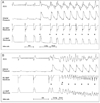In a swine model, chest compressions cause ventricular capture and, by means of a long-short sequence, ventricular fibrillation
- PMID: 19808420
- PMCID: PMC2756676
- DOI: 10.1161/CIRCEP.108.767855
In a swine model, chest compressions cause ventricular capture and, by means of a long-short sequence, ventricular fibrillation
Abstract
Background: During resuscitation, fibrillation often recurs. In swine, we studied refibrillation after long-duration ventricular fibrillation, investigating an association with chest compressions (CCs).
Methods and results: In protocol A, 47 episodes of long-duration ventricular fibrillation lasting at least 2.5 minutes were induced in 8 animals. After defibrillation, CCs were required for 35 episodes and delivered with a pneumatic device (Lucas cardiopulmonary resuscitation). In 9 episodes, refibrillation occurred within 2 seconds of CC initiation (group 1) and in 26 episodes, CCs were delivered without refibrillation (group 2). From the ECG and intracardiac electrodes, the RR interval preceding CCs, the shortest cycle length during the first 2 CCs (short), and the preceding cycle length (long) were measured. A similar study was conducted in 3 more animals without intracardiac catheters (protocol B). In protocol A, the mean RR before CC was 665+/-292 ms in group 1 and 769+/-316 in group 2. CCs stimulated ventricular beats in all 35 episodes. The short and long intervals were shorter in group 1 (215+/-31 and 552+/-210 ms) than in group 2 (402+/-153 and 699+/-147 ms) (P=0.009 and P=0.04, respectively). The prematurity index (short/RR) was lower in group 1 than in group 2 (0.35+/-0.09 vs 0.58+/-0.21; P<0.01). A short interval <231 ms predicted refibrillation with 88% sensitivity and 91% specificity. In protocol B, CCs were required in 11 episodes, causing ventricular stimulation in all of them and ventricular fibrillation within the first 2 CCs in 3.
Conclusions: Under some conditions, CC during resuscitation can stimulate the ventricles and initiate ventricular fibrillation by a long-short sequence.
Keywords: Chest Compressions; Refibrillation; Ventricular Capture.
Conflict of interest statement
None of the authors have any conflict of interest to disclose.
Figures






References
-
- Zipes DP, Wellens HJ. Sudden cardiac death. Circulation. 1998;98:2334–2351. - PubMed
-
- State-specific mortality from sudden cardiac death--United States, 1999. MMWR Morb Mortal Wkly Rep. 2002;51:123–126. - PubMed
-
- Cummins RO, Eisenberg MS, Hallstrom AP, Litwin PE. Survival of out-of-hospital cardiac arrest with early initiation of cardiopulmonary resuscitation. Am J Emerg Med. 1985;3:114–119. - PubMed
-
- White RD, Hankins DG, Bugliosi TF. Seven years' experience with early defibrillation by police and paramedics in an emergency medical services system. Resuscitation. 1998;39:145–151. - PubMed
-
- White RD, Hankins DG, Atkinson EJ. Patient outcomes following defibrillation with a low energy biphasic truncated exponential waveform in out-of-hospital cardiac arrest. Resuscitation. 2001;49:9–14. - PubMed
Publication types
MeSH terms
Grants and funding
LinkOut - more resources
Full Text Sources
Other Literature Sources
Medical

